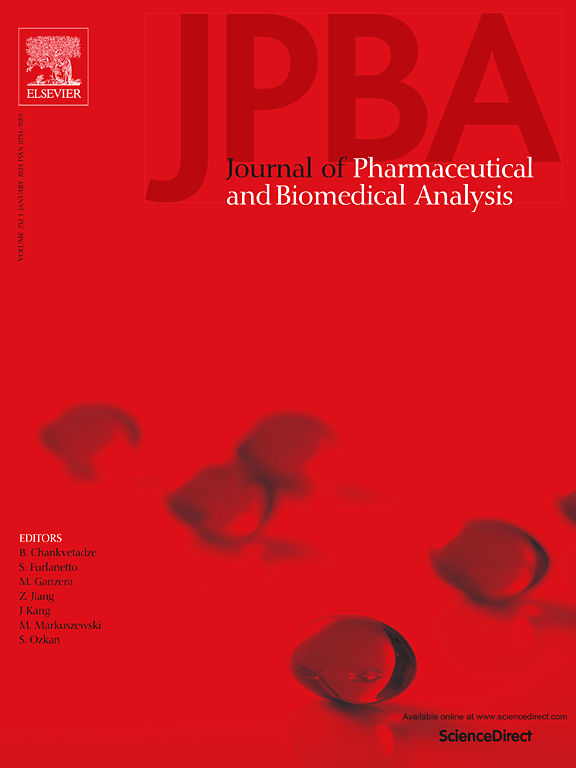A critical review of bioanalytical and clinical applications of solid phase microextraction
IF 3.1
3区 医学
Q2 CHEMISTRY, ANALYTICAL
Journal of pharmaceutical and biomedical analysis
Pub Date : 2024-09-27
DOI:10.1016/j.jpba.2024.116487
引用次数: 0
Abstract
Studying the functions, mechanisms, and effects of drugs and other exogenous compounds on biological systems, together with investigations performed to understand biosystems better, comprises one of the most fascinating areas of research. Although classical sample preparation techniques are dominantly used to infer the relevant information from the investigated system, they fail to meet various imperative requirements, such as being environmentally friendly, applicable in-vivo, and compatible with online analysis. As a chameleon in the analytical toolbox, solid phase microextraction (SPME) is one of the best tools available for studying biological systems in unconventional ways. In this review, SPME is spotlighted, and its capability for bioanalytical applications, including drug analysis, untargeted and targeted metabolomics, in-vivo and clinical studies, is scrutinized based on studies reported in the past five years. In addition, novel extractive phases and instrumental coupling strategies developed to serve bioanalytical research are discussed to give the perspective for state-of-the-art and future developments. The literature assessment showed that SPME could act as a critical tool to investigate in-vivo biological systems and provide information about the elusive portion of the metabolome. Moreover, recently introduced miniaturized SPME probes further improved the low-invasive nature of the sampling and enabled sampling even from a single cell. The coupling of SPME directly to mass spectrometry significantly reduced the total analytical workflow and became one of the promising tools suitable for fast diagnostic purposes and drug analysis. The numerous applications and advancements reported in bioanalysis using SPME show that it will continue to be an indispensable technique in the future.
固相微萃取的生物分析和临床应用评述。
研究药物和其他外源化合物对生物系统的功能、机制和影响,以及为更好地了解生物系统而进行的调查,是最引人入胜的研究领域之一。虽然传统的样品制备技术主要用于从研究系统中推断相关信息,但它们无法满足各种迫切的要求,如环保、适用于体内、与在线分析兼容等。作为分析工具箱中的变色龙,固相微萃取(SPME)是以非常规方式研究生物系统的最佳工具之一。在这篇综述中,我们将重点介绍固相微萃取技术,并根据过去五年的研究报告,仔细分析它在生物分析应用方面的能力,包括药物分析、非靶向和靶向代谢组学、体内和临床研究。此外,还讨论了为服务于生物分析研究而开发的新型萃取相和仪器耦合策略,从而为最新技术和未来发展提供了视角。文献评估显示,SPME 可以作为研究体内生物系统的重要工具,提供有关代谢组中难以捉摸部分的信息。此外,最近推出的微型 SPME 探针进一步提高了采样的低侵入性,甚至可以从单个细胞中采样。将 SPME 直接与质谱联用,大大减少了整个分析工作流程,成为适合快速诊断和药物分析的有前途的工具之一。使用 SPME 进行生物分析的众多应用和进展表明,它在未来仍将是一种不可或缺的技术。
本文章由计算机程序翻译,如有差异,请以英文原文为准。
求助全文
约1分钟内获得全文
求助全文
来源期刊
CiteScore
6.70
自引率
5.90%
发文量
588
审稿时长
37 days
期刊介绍:
This journal is an international medium directed towards the needs of academic, clinical, government and industrial analysis by publishing original research reports and critical reviews on pharmaceutical and biomedical analysis. It covers the interdisciplinary aspects of analysis in the pharmaceutical, biomedical and clinical sciences, including developments in analytical methodology, instrumentation, computation and interpretation. Submissions on novel applications focusing on drug purity and stability studies, pharmacokinetics, therapeutic monitoring, metabolic profiling; drug-related aspects of analytical biochemistry and forensic toxicology; quality assurance in the pharmaceutical industry are also welcome.
Studies from areas of well established and poorly selective methods, such as UV-VIS spectrophotometry (including derivative and multi-wavelength measurements), basic electroanalytical (potentiometric, polarographic and voltammetric) methods, fluorimetry, flow-injection analysis, etc. are accepted for publication in exceptional cases only, if a unique and substantial advantage over presently known systems is demonstrated. The same applies to the assay of simple drug formulations by any kind of methods and the determination of drugs in biological samples based merely on spiked samples. Drug purity/stability studies should contain information on the structure elucidation of the impurities/degradants.

 求助内容:
求助内容: 应助结果提醒方式:
应助结果提醒方式:


